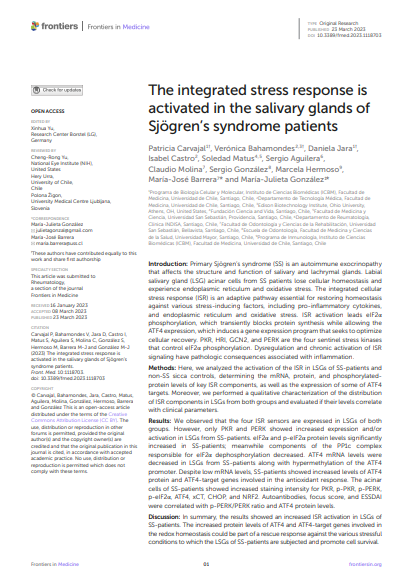The integrated stress response is activated in the salivary glands of Sjogren's syndrome patients

Fecha
2023-03-23Autor
Carvajal, Patricia
Bahamondes, Verónica
Jara, Daniela
Castro, Isabel
Matus, Soledad
Aguilera, Sergio
Molina, Claudio
González, Sergio [Univ Mayor, Escuela Odontol, Fac Med & Ciencias Salud, Chile]
Hermoso, Marcela
Barrera, María-José
González, María-Julieta
Ubicación geográfica
Notas
HERRAMIENTAS
Acceda a títulos restringidos
¿Cómo descargar?Resumen
IntroductionPrimary Sjogren's syndrome (SS) is an autoimmune exocrinopathy that affects the structure and function of salivary and lachrymal glands. Labial salivary gland (LSG) acinar cells from SS patients lose cellular homeostasis and experience endoplasmic reticulum and oxidative stress. The integrated cellular stress response (ISR) is an adaptive pathway essential for restoring homeostasis against various stress-inducing factors, including pro-inflammatory cytokines, and endoplasmic reticulum and oxidative stress. ISR activation leads eIF2 alpha phosphorylation, which transiently blocks protein synthesis while allowing the ATF4 expression, which induces a gene expression program that seeks to optimize cellular recovery. PKR, HRI, GCN2, and PERK are the four sentinel stress kinases that control eIF2 alpha phosphorylation. Dysregulation and chronic activation of ISR signaling have pathologic consequences associated with inflammation. MethodsHere, we analyzed the activation of the ISR in LSGs of SS-patients and non-SS sicca controls, determining the mRNA, protein, and phosphorylated-protein levels of key ISR components, as well as the expression of some of ATF4 targets. Moreover, we performed a qualitative characterization of the distribution of ISR components in LSGs from both groups and evaluated if their levels correlate with clinical parameters. ResultsWe observed that the four ISR sensors are expressed in LSGs of both groups. However, only PKR and PERK showed increased expression and/or activation in LSGs from SS-patients. eIF2 alpha and p-eIF2 alpha protein levels significantly increased in SS-patients; meanwhile components of the PP1c complex responsible for eIF2 alpha dephosphorylation decreased. ATF4 mRNA levels were decreased in LSGs from SS-patients along with hypermethylation of the ATF4 promoter. Despite low mRNA levels, SS-patients showed increased levels of ATF4 protein and ATF4-target genes involved in the antioxidant response. The acinar cells of SS-patients showed increased staining intensity for PKR, p-PKR, p-PERK, p-eIF2 alpha, ATF4, xCT, CHOP, and NRF2. Autoantibodies, focus score, and ESSDAI were correlated with p-PERK/PERK ratio and ATF4 protein levels. DiscussionIn summary, the results showed an increased ISR activation in LSGs of SS-patients. The increased protein levels of ATF4 and ATF4-target genes involved in the redox homeostasis could be part of a rescue response against the various stressful conditions to which the LSGs of SS-patients are subjected and promote cell survival.
URI
https://repositorio.umayor.cl/xmlui/handle/sibum/9524https://www.ncbi.nlm.nih.gov/pmc/articles/PMC10079080/pdf/fmed-10-1118703.pdf
https://doi.org/10.3389%2Ffmed.2023.1118703
https://www.frontiersin.org/articles/10.3389/fmed.2023.1118703/pdf?isPublishedV2=False
Coleccion/es a la/s que pertenece:
Si usted es autor(a) de este documento y NO desea que su publicación tenga acceso público en este repositorio, por favor complete el formulario aquí.